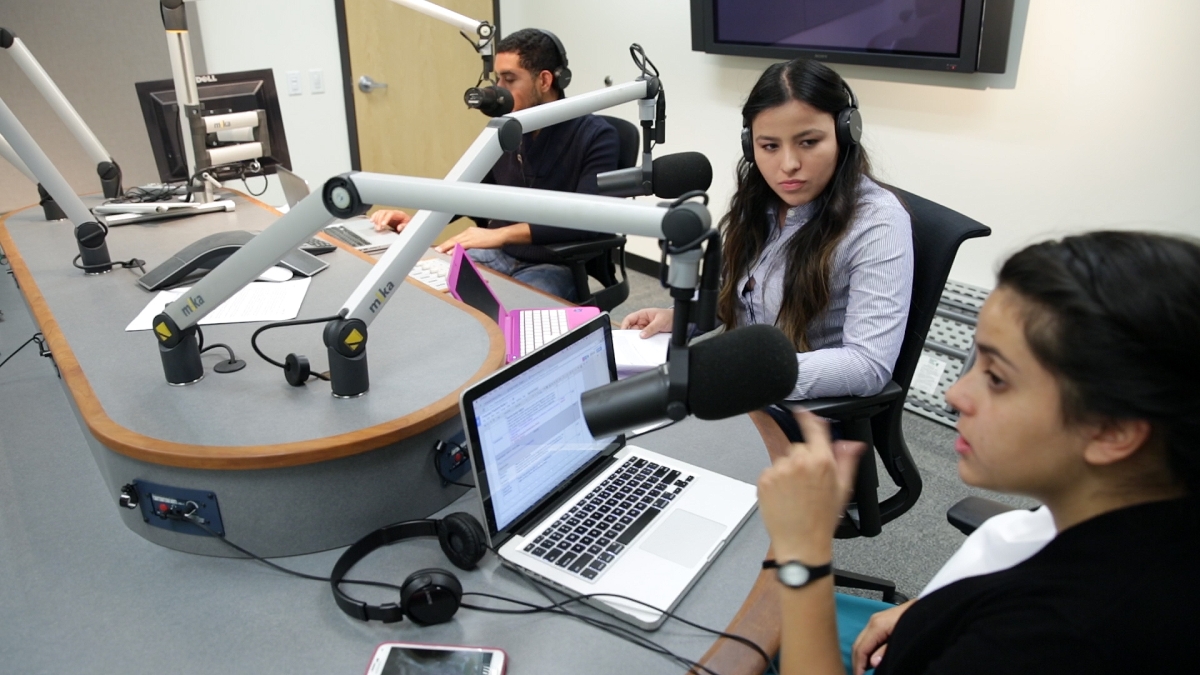Immersion is key to learning a second language, and the best way to achieve that is by living in a place where that language is predominantly spoken. That's not always an option, however, with time and money constraints. Fortunately, raising the stakes associated with speaking a language can be just as effective.
That is precisely what “Spanish 494 – Spanish Language Radio: Analysis and Practice” does for students at Arizona State University.
Offered through the College of Letters and Sciences since fall 2014, Spanish 494 gives students the opportunity to gain real-world experience in researching, writing and producing a live Spanish radio show.
The show, called Los Diablos Radio, is broadcast via The Blaze, the Walter Cronkite School of Journalism and Mass Communication’s student-run radio station. It highlights music, community events and other themes of interest pertaining to Hispanics in the United States.
“The course helps [students] with their confidence in speaking, as well as their presentation skills. It really teaches them critical thinking skills, especially how to express themselves in Spanish,” said Barbara Lafford, faculty head of Language and Cultures for the college and director of the Spanish for the Professions program.
The course was originally developed by Carmen King de Ramirez, former coordinator of the program.
Open to students from any major, the course can be used as part of a minor or a certificate in Spanish for the Professions. Past students of the course, for example, have been majors in criminology, interdisciplinary studies and journalism.
Biochemistry senior Abdi Lopez is taking the course as part of her minor in Spanish for the Professions. For her, speaking Spanish well is a cultural necessity.
“It’s of utmost importance to have the ability to present my ideas fluently in my native language. I want to communicate effectively with the community that has made me who I am,” she said.
And though Spanish is not the most predominantly spoken language in the U.S., Hispanics constitute the fastest-growing segment of the country’s population — in Arizona, they make up 30 percent of the state’s population and 41 percent of the population of PhoenixAccording to the 2012 U.S. Census report..
A native of Bolivia, course instructor Nelson SuarezNelson Suarez is a lecturer in the College of Letters and Sciences at Arizona State University. said the course is “very challenging but also really interesting.”
“[The students] love shaping the program and reaching out to the Hispanic community … bringing out cultural differences, and deciding how to integrate them,” Suarez said.
Over the course of the fall 2015 semester, Suarez’s students produced three broadcasts for Los Diablos Radio. For each one, they spent about four weeks preparing by delegating such tasks as researching and brainstorming topics, securing and interviewing guests, and even choosing the music.
One of the broadcasts focused on success stories of Hispanic peoples and featured an interview with the group of students from Carl Hayden High School who made national news when they beat out Massachusetts Institute of Technology and other colleges to win a national robotics competition — their story was made into the documentary film “Underwater Dreams.”
Broadcast junior Maria Berelleza said she relishes the chance to interview people from the local Hispanic community whom she admires, even if that feeling of nervousness and excitement before each live broadcast never goes away.
“I have learned so much from this class,” she said, both from her fellow students and from professionals in her field.
But the biggest reward has been learning the language itself.
“Learning any other language is important,” said Berelleza. “It helps you everywhere you go.”
This class is just one example of how language can be used for a specific purpose. ASU’s College of Letters and Sciences faculty have been taking a leadership role in the international “Language for Specific Purposes” academic community and are hosting the next international symposium at the Downtown Phoenix campus, March 17-19, 2016.
More Law, journalism and politics

A new twist on fantasy sports brought on by ASU ties
A new fantasy sports gaming app is taking traditional fantasy sports and mixing them with a strategic, territory-based twist.Maptasy Sports started as a passion project for Arizona State University…

'Politics Beyond the Aisle' series to explore the stories of public officials
In an effort to build a stronger connection between students and political and civic leaders, Arizona State University’s School of Politics and Global Studies hosted the first event of its new series…

ASU committed to advancing free speech
A core pillar of democracy and our concept as a nation has always been freedom — that includes freedom of speech. But what does that really mean?Higher education doesn’t have an agenda to curate a…


